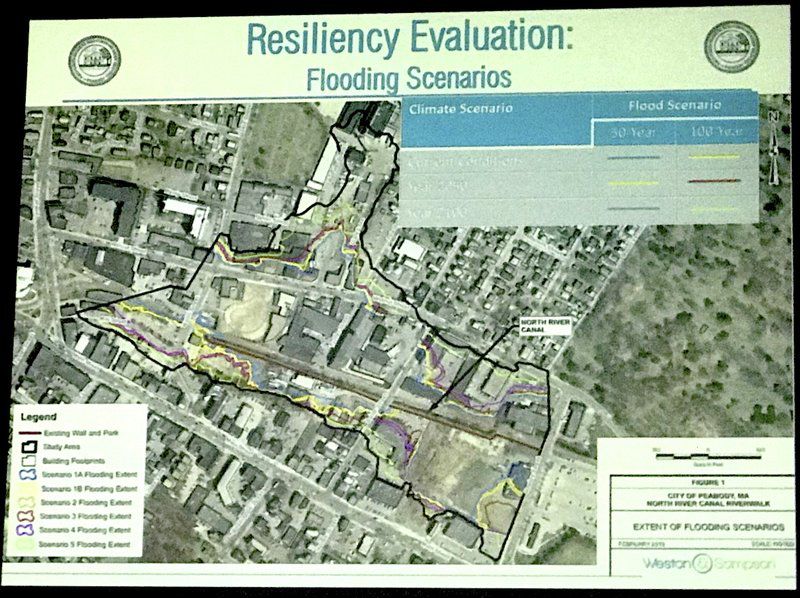PEABODY — The Riverwalk project has been studied and discussed for decades, but now the push is on to fix the canal wall and create a recreational path along the south side of the North River Canal.
The goal would be to repair or replace portions of the existing canal wall, which is made up of granite blocks, and create a third of a mile Riverwalk trail running between Wallis to Howley streets.
The project would create some flood storage in an area prone to flooding, create a new amenity in the city, and spruce up a rundown part of the downtown dominated by industrial uses and train tracks running along the north side of the canal. The ultimate goal would be to extend the Riverwalk all the way to the Salem Depot.
Peabody’s Assistant Director of Planning Brendan Callahan and project officials from the engineering firm Weston and Sampson outlined the work before about 20 residents, officials and several city councilors in the Wiggin Auditorium in City Hall Thursday night.
“We think we have come up with a viable project,” Callahan said, something that could be permitted and constructed.
Project officials estimate the cost to repair or replace the canal wall with a sheet pile wall and a sloped bank could be $3 million to $7 million, with the cost dependent on environmental factors, said Scott Bruso, team leader with Weston and Sampson.
Over the years, various city, state and federal grants have contributed to study of the project, including a U.S. Environmental Brownfield Assessment Grant from 2001 and city and state money to acquire an industrial property at 24 Caller St. one of the largest parcels along the proposed Riverwalk. Callahan said the city is in the process of acquiring 24 Caller St., and after that happens, the city would then conduct an environmental site assessment of the property.
Money for this latest study came in 2018 with a $224,000 Municipal Vulnerability Preparedness Action Grant from the Massachusetts Executive Office of Energy and Environmental Affairs. The city provided a $75,000 match to this grant. Project officials are hoping the city gets the next round of funding from the MVP program to push the project from its present phase of 25% design to 75% design.
The North River Canal is a walled canal made up of stacked granite blocks that connects the North River from Peabody Square to the Salem border. The 1,600-foot long Riverwalk would run between Wallis and Howley streets, with Caller Street in the middle.
“It’s a corridor that the city has turned its back on and really we have this opportunity to really turn this into an asset for the city,” said George Naslas, a vice president with Weston and Sampson.
Of course, flooding is a major concern in this part of the city.
Weston and Sampson Lead Resiliency Engineer Julie Eaton looked at flooding under climate change conditions in 2050. She used a series of maps to show how the extent of flooding would worsen over time. The Riverwalk plan includes the creation of some flood storage, she said.
Bruso looked at the condition of the south wall, which ranged from good around Wallis Street, to poor and in need of full or partial replacement toward Howley Street. He also said that the existing stacked granite wall would not be able to hold the Riverwalk.
The engineers evaluated five different kinds of walls types and settled on a sheet pile wall, essentially steel sheets that would make up the canal walls. It scored highest for resiliency and flood storage, durability and maintenance, environmental impact, construction and easements, permitting, regulatory favorability and cost.
Landscape architect Jeanne Lukenda said they were looking at concepts that could bring the community together “in a new way” when thinking about the Riverwalk.
There are complexities and opportunities, Lukenda said. She suggested the Riverwalk be lined with trees to provide shade and a separation between public and private property.
Lukenda said there is an opportunity to discuss various edges, including a planting edge, a railing edge and an edge that includes seating. Lukenda also said they were looking for feedback on the walkway surface, seating and gathering spaces, native plant material and the type of railing material.
Some in the audience had various concerns.
Joel Whitman, who owns property on Walnut Street, asked Callahan about the possibility of forming a subcommittee or a neighborhood group to look at the Riverwalk. Callahan said that has not been discussed, “but we could definitely look into that.”
Travis Wojcik of Peabody commented that the city has a problem with vandalism and that has to be taken into consideration when it comes to materials used in the Riverwalk.
“I think it’s a beautiful project,” he said after the meeting, “and I will benefit from it because I rode my bike down Walnut Street to get here.”
Salem State University biology Professor Alan Young, representing Salem Sound Coastwatch, was concerned the sheet pile wall would be bad for smelt ecology in the river in the vicinity of Howley Street, because it would not provide habitat for the fish.
Peabody attorney David Ankeles, who represents the Azorean Brotherhood, which owns the Holy Ghost Society Cultural Center at 20 Howley St., said there were concerns coming from his client, as the Riverwalk would border their property.
“We have families, we have children, it’s a community center religious-type operation down there,” said Ankeles, who asked about how they intend to keep kids from getting into the river.
Callahan said there will be barriers, but they have not gotten to that level of detail.
The timetable for the project moving forward depends on funding, and the city is aggressively pursuing funding sources, Callahan said. He added that the city and Weston and Sampson have come a long way on the Riverwalk project in the past eight months.
Staff writer Ethan Forman can be reached at 978-338-2673, by email at eforman@salemnews.com or on Twitter at @TannerSalemNews.

